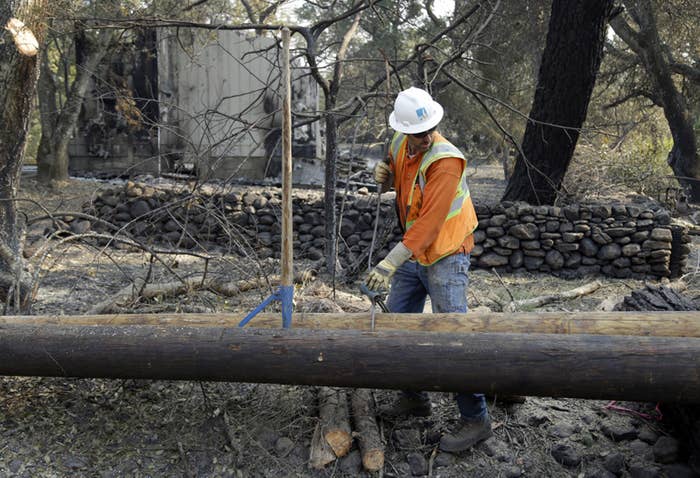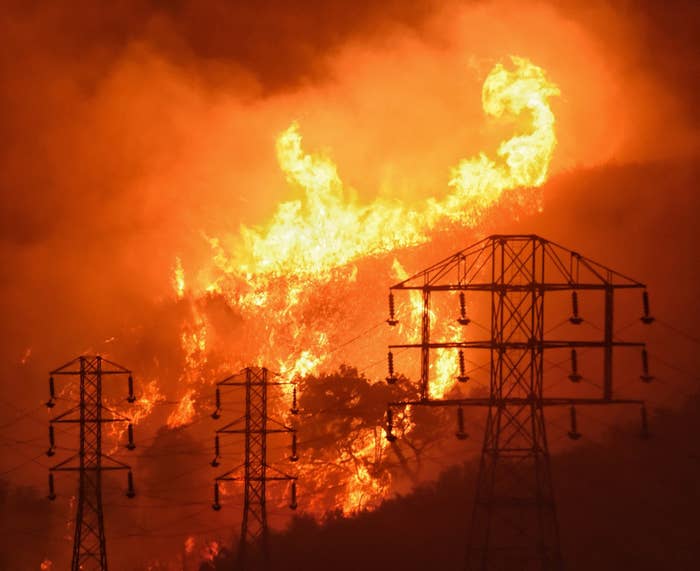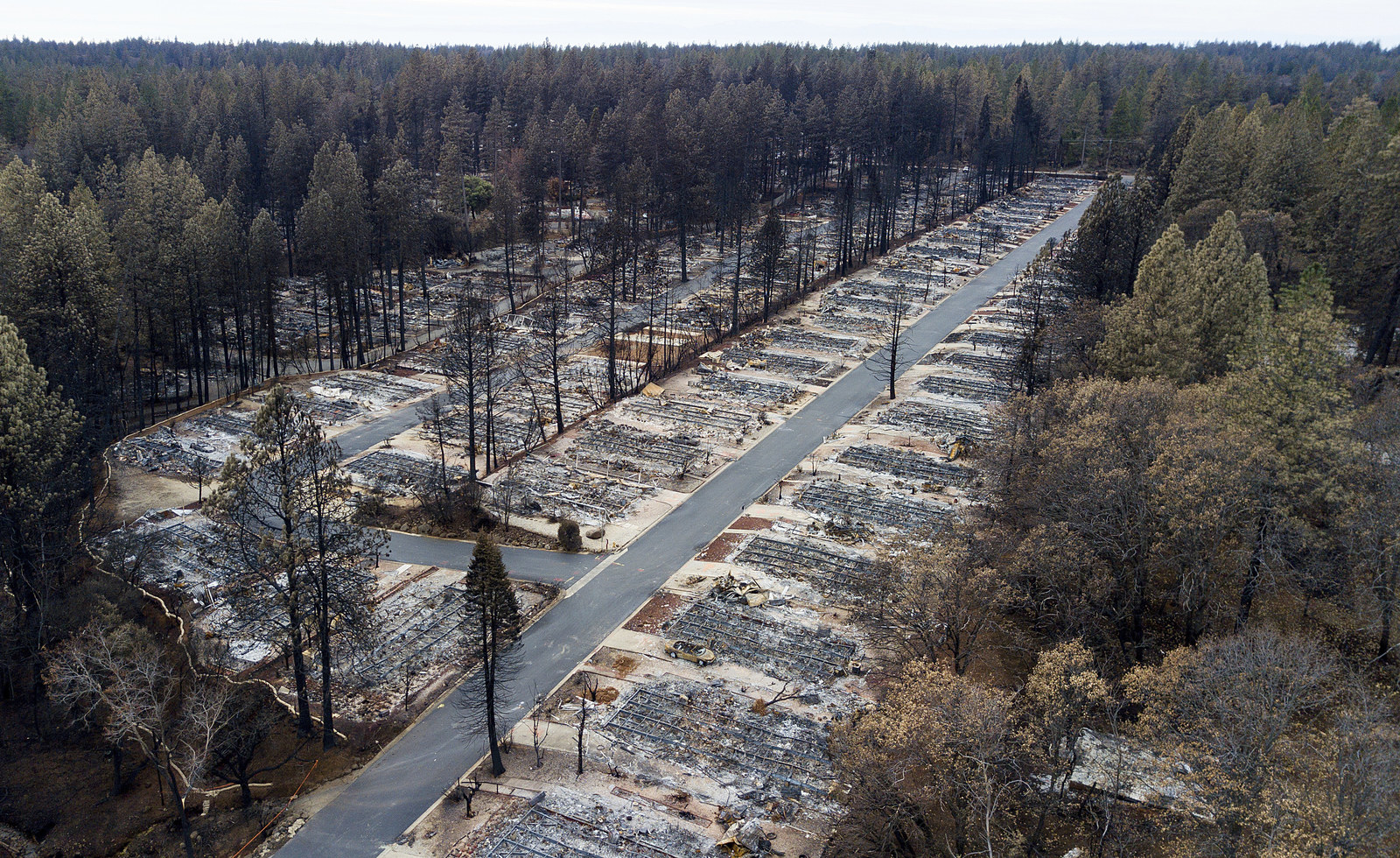
LOS ANGELES — Pacific Gas & Electric, the biggest utility company in the country, filed for bankruptcy protection Tuesday as it faces unprecedented challenges from climate change, billions of dollars in payouts to California wildfire victims, and calls that it can’t be trusted to prevent more death and destruction.
It was the first time a major corporation has filed for bankruptcy at least partially as a result of climate change, and it comes as a federal judge is requiring the California utility to plan for this summer’s wildfire season, proposing drastic prevention measures in a stop-gap effort to save lives. In recent years, PG&E has been found responsible for 17 wildfires, some of them deadly, and it’s still under investigation for the record-breaking Camp fire that killed 88 people.
“Throughout this process, we are fully committed to enhancing our wildfire safety efforts, as well as helping restoration and rebuilding efforts across the communities impacted by the devastating Northern California wildfires,” said PG&E interim CEO John Simon.
The potential for future fires has spooked investors, and the company’s stock has plummeted as it finds itself needing reserves of cash to settle lawsuits and upgrade its vast infrastructure. But even as the company has acknowledged it needs to change the way it does business, it has pushed back against a proposal to inspect all its power lines and trim millions of trees that could spark fire wildfires.
“Speaking as a Californian, I find it very disappointing,” said Michael Wara of the Stanford Woods Institute for the Environment. “I want PG&E to be rolling up their sleeves, having thrown the assumption of how they’re going to do business out the window. Because hello, they are out the window at this point.”

Climate change has created a “new abnormal” for the state, former governor Jerry Brown said last year as the state once again erupted into flames. Fire weather — days of strong winds, high temperatures, and low humidity — is more frequent. A spark in those conditions can erupt into a fast-moving tornado of flames, leveling anything or anyone caught in its path.
Adapting the 20th-century power grid to this new reality will be complicated and expensive, PG&E said in a court filing last week. It’s a problem that needs to be solved by regulators, government leaders, and experts in the utility field, the company said.
“The problems are grave; they are substantial — PG&E has nearly 100,000 miles of overhead lines across Northern California; and they need to be solved as quickly as possible,” the company said. “PG&E is committed to making that happen.”
In a filing obtained by BuzzFeed News on Monday, the California Public Utilities Commission agreed that PG&E’s crisis should be solved by the company, regulators, and officials working together. Utility companies by law aren’t allowed to put public safety above the reliability of service, it noted, and a proposal to power down any lines that haven’t been certified as safe goes too far.
“In public utility regulation, safety, reliability, and consideration of costs and timing are never considered in isolation,” the CPUC wrote.
Dozens of protesters attended an emergency CPUC meeting Monday, opposing its approval of a $6 billion loan during PG&E’s bankruptcy, and what they described as corporate greed and mismanagement on the part of the utility. They chanted, “Wall Street bailout, we say no,” and read the names of people killed in wildfires that have ravaged the state.
Whether PG&E is going far enough to protect Californians will be heard in court Wednesday. Judge William Alsup, who is is supervising the utility’s criminal probation for a deadly gas explosion in San Bruno in 2010, has already said he can’t trust the utility company to make good on its promises.
“A corporation cannot go to prison, so the criminal judgment imposed the largest fine allowed by law and several conditions of probation,” Alsup said in a filing earlier this month, adding it was the court’s responsibility to protect the public against PG&E and deter other utilities from similar behavior.
Alsup proposed drastic action over the next five months to prevent another utility-caused conflagration in 2019. He called on PG&E to inspect its entire grid, remove or trim all trees that could fall on power lines, and fix weak or damaged equipment that can’t withstand high winds. Given its history of false reporting, the inspections must be done by an engineer and certified under oath in writing, Alsup said, and once wildfire season begins, PG&E may only supply electricity to the sections of its grid certified as safe.
The conditions are meant to bring the number of wildfires caused by PG&E to zero in 2019, Alsup said.
“This will likely mean having to interrupt service during high-wind events (and possibly at other times) but that inconvenience, irritating as it will be, will pale by comparison to the death and destruction that otherwise might result from PG&E-inflicted wildfires,” the judge said.
But the judge’s plan is simply impossible, PG&E said in its response. It estimated it would need to remove 100 million trees in its 70,000-square-mile territory, an endeavor that would take 650,000 full-time tree trimmers. Complying with the order would cost between $75 and $150 billion, PG&E estimated — money it doesn’t have, which could only be raised by spiking the power bills of its 16 million customers.
Even if it could pay for the changes, PG&E is arguing the plan would violate state and federal regulations. And the cost-free suggestion by the judge — cutting power during risky weather — could have serious consequences for hospitals, firefighters, and services essential to evacuating communities, like streetlights and communications systems, PG&E said.
“Shutting off power is not simply a matter of inconvenience,” the utility said. “It is dangerous and potentially fatal.”
Regulators require a power shutoff to be a last resort, and first responders and residents must be warned as early as possible ahead of time.
We know how much our customers rely on reliable electric service & would only consider temporarily turning off power in the interest of safety when extreme fire danger conditions occur, and as a last resort. Learn more about Public Safety Power Shutoff: https://t.co/YB5QedueIf
PG&E’s legal arguments are understandable, Wara said, but given the scope of the problem, and the reality of climate change, the company needs to make unprecedented moves to solve it. Since PG&E is already losing billions of dollars each year in compensating wildfire victims, investing billions into safety would be a rational way to prepare for the future, he said.
“For them to act like that’s absurd is, I think, an indication of how strategic leadership at the head of the company is lacking,” Wara said.
In the immediate future, the utility has taken steps to keep its power operations running during bankruptcy, so the lights will stay on. Lawsuits by fire victims will be consolidated into the federal bankruptcy court proceedings, which will likely speed the payout process, though it could mean lower settlements for individuals.

Given the scope of the recent fires, bankruptcy wasn’t unexpected, said Patrick McNicholas, one of a group of lawyers representing 2,500 fire victims statewide.
He said victims should remain confident they’ll be compensated for their losses, but more broadly, this could be a turning point for how utilities operate.
“The aviation industry has a culture of safety, which has paid off huge,” he said. “The same thing needs to occur with utilities. For the last three decades, they’ve failed to invest in safety, in upgrading the integrity of their systems.”
Jerry Hill, the state senator who represents San Bruno, wants to see PG&E follow the example set in Southern California by San Diego Gas & Electric. After a fire in 2007, the utility installed steel power poles, a new weather monitoring system, and de-energized lines on windy days — all things that PG&E could have been doing for years, Hall said.
Longer term, it’s an open question how the state’s utilities will adapt to a changing climate. Financial markets have already shown they’re not willing to risk loaning money to PG&E under current circumstances, Wara said. When ratepayers’ electricity bills go up, California will have to make tough decisions on how to keep power affordable while also keeping people safe.
“The part where we figure out how to operate a 20th-century system, the grid, differently because of the impact of climate change has not happened yet,” he said. “But I think we’ll get there. I think we’re starting down that path.”

